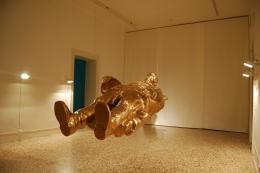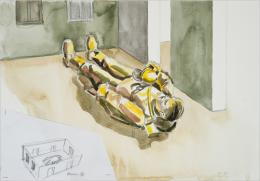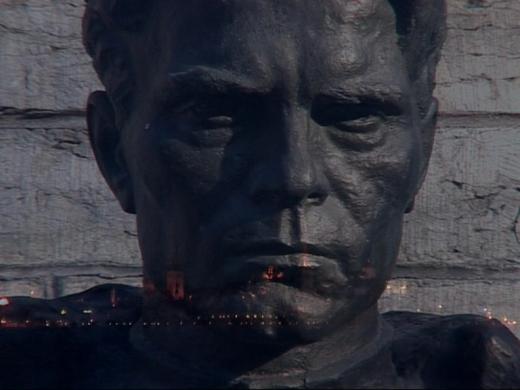ESTONIAN EXHIBITION AT THE 53rd VENICE BIENNIAL
After-War by KRISTINA NORMAN
As a person who is active in the visual arts and documentary filmmaking, I am investigating my immediate surroundings and also intervening in them. I’m from a country where the past strongly affects the present. The aftermath of World War II, or The Great Patriotic War as it is known in Russia, is interpreted in two different ways in Estonia: the Estonian majority and the Russian minority form two separate ‘memory collectives’, and I position myself between the two due to my mixed background.
After-War is a case study of the conflict surrounding the Bronze Soldier monument in Tallinn. The statue from 1947 that marked the grave of Red Army soldiers became a constant source of conflict in re-independent Estonia. For most Estonians it is a symbol of Soviet occupation and repression, mass deportations, etc. For many Russians it symbolizes victory over Nazism, and ultimately became a positive signifier of their Russian identity in Estonia after the collapse of the Soviet Union in 1991.
The conflict that had been simmering beneath the surface of Estonian society suddenly erupted in late April 2007. Amidst growing tensions, the Estonian government relocated the Bronze Soldier from its quite prominent location in the centre of Tallinn to a military cemetery 2.5 km away. It could be, the intention of this act was to make the local Russian community, whose many members are deprived of the opportunity to affect their lives politically, and who almost constitute a separate culture (with the statue of the mourning soldier at its centre), invisible for Estonians. This symbolic act of marginalization carried out by those in power was followed by two nights of rioting in the streets of Tallinn. According to the media, it all ended as a successful police operation, and the government won the media war at the international level as well. The Russian population in Estonia was said to have shown its ‘real face’ – that is, the defenders of the monument turned out to be mere criminals and nothing more.
Two years after these events – on 9 May 2009, the day when many Russian people traditionally celebrate Victory Day, thus making their cultural identity visible – I brought a full-size golden replica of the sculpture to its former location, which still remains a sacred place, although the government claims it is now profane. With this act I visualized my argument that although the upstaged problems surrounding the Bronze Soldier and the drama of its relocation are now neatly tucked away and removed from the public space, they nevertheless continue to exist and they should be dealt with.
If ‘after-party’ is something that follows the ‘official event’, then After-War is an art research project, a participatory experiment and an intervention through which I am trying to create a possibility for more tolerant approaches to history between official historical writings. By not choosing a historical ‘truth’ from either of the confrontational ‘memory collectives’, I am asking uncomfortable questions regarding democracy, tolerance, xenophobia and fear.
After-War is a comprehensive installation environment where the same symbol (i.e. the Bronze Soldier) is represented in five different keys and contexts. Although it seems that the case of the Bronze Soldier orbits around a single monument, for me it rather serves as a pretext for decoding existing cultural practises and casting doubt on the rhetoric of (historical) winners and losers.
 PRESS RELEASE 02.06.2009
PRESS RELEASE 02.06.2009
On Saturday, 06.06.2009, at 6.00 pm the inauguration of the Estonian pavilion at the 53rd International Art Exhibition – La Biennale di Venezia – takes place in Palazzo Malipiero, San Marco 3079, Venezia.
KRISTINA NORMAN’s project “After-War” represents Estonia at the 53rd International Art Exhibition. The exposition at the Estonian Pavilion is curated by MARCO LAIMRE and commissioned by the Center for Contemporary Arts, Estonia. The venue is open to the public from June 7th to November 22nd 2009.
The venue for the Estonian exhibit in Venice in 2009 is the Palazzo Malipiero (1st floor), San Marco 3079, which is the same venue the Estonian exposition was shown in 2003, 2005 and 2007. The exhibition is accompanied by a substantial catalogue with texts illustrated by the artist.
Estonia’s participation at the 53rd International Art Exhibition in Venice is financed by the Estonian Ministry for Culture and the Cultural Endowment of Estonia. Estonia has exhibited at the Venice Biennale since 1997. The Center for Contemporary Arts, Estonia is the official representative for the Estonian exposition at the Venice Biennale.
The competition for the 2009 Estonian exhibit attracted 20 entries and the winner was chosen by an international nine-member panel of representatives from a variety of institutions.
For further information please contact:
Elin Kard
e-mail: elin[at]cca dot ee
gsm: +372 52 85 324
Johannes Saar
e-mail: johannes[at]cca dot ee
phone: +390 415 201 342
Center for Contemporary Arts, Estonia
Vabaduse väljak 6
10146 Tallinn
ESTONIA
phone. +372 631 40 50
e-mail: post[at]cca dot ee
Image: Kristina Norman, Central Golden Object (2009, sculpture installation)
 PRESS RELEASE 19.01.2009
PRESS RELEASE 19.01.2009
53. Esposizione Internazionale d’Arte – La Biennale di Venezia
53rd International Art Exhibition – La Biennale di Venezia
53. rahvusvaheline Veneetsia kunstibiennaal – La Biennale di Venezia
KRISTINA NORMAN
After-War
Palazzo Malipiero, San Marco 3079, Venezia
From June 7th to November 22nd, 2009
KRISTINA NORMAN’s project “After-War” will represent Estonia at the 53rd International Art Exhibition, La Biennale di Venezia. The exposition at the Estonian Pavilion is curated by MARCO LAIMRE and commissioned by the Center for Contemporary Arts, Estonia.
Kristina Norman, the Estonian representative exhibiting at the 53rd International Art Exhibition, La Biennale di Venezia, belongs to the generation that entered the art scene in the ‘00s. She deals with political, provocative, documentary and research-based art. Norman’s work is highly context-centred and has grown from her immediate surroundings. "After-War" is a comprehensive installation environment comprised of videos, photographs and objects in five separate spaces.
The installation is based on a specific event and the issues surrounding it that must be regarded as the most traumatic event in Estonian society since the restoration of independence in 1991, and one which aroused the most public discussion.
In April 2007, the Estonian government removed a monument commonly referred to as the "Bronze Soldier" from a prominent place in the centre of Tallinn, where it had stood since 1947. The memorial, officially called "The Monument to the Liberators of Tallinn", was dedicated to the Red Army soldiers who fell during what in Russia is known as The Great Patriotic War (WWII), but for most Estonians this memorial was a symbol of Soviet occupation. The monument was removed from its original site and relocated 2.5 km away at the military cemetery. The original location was then planted with low shrubs and flowers as if there had never been a monument there. This "psycho-geographical" manoeuvre carried out by the Estonian government provoked protest by the Russian-speaking community and was followed by two nights of rioting on the streets of Tallinn. Using the concept of a memory community, Kristina Norman describes and analyses past events and proposes subsequent cultural practice. The title of the work "After-War" is a reference to the idea that the war is over, but the conflict still continues.
Kristina Norman, “My art practice is interwoven with documentary, and for me the video camera is an indispensable tool. While making documentary films, I am collecting information and material for my art projects and visa versa. In a way, “After-War” is socio-cultural research and an experiment during the course of which I am mapping and dissecting the “monument incident”. I am fascinated by the theme of how values are formed and the problematics of the sacred and the profane. I am also interested in the relationship between memory and history in the construction of national and state identity.”
The exhibition is accompanied by a substantial catalogue with texts illustrated by the artist. In this publication, the “After-War” project and the conflict surrounding the monument are discussed by Aleksander Astrov, philosopher and lecturer in International Relations and European Studies at the Central European University; Airi Triisberg, cultural theorist; Andres Kurg, architectural theorist; Marco Laimre, the curator and Kristina Norman, the artist.
Press release compiled by Marco Laimre
Kristina Norman was born in 1979 in Tallinn, where she lives and works today. She has studied at the Estonian Academy of Arts and worked as an art teacher. She is currently working on a feature-length documentary film about the makers of the monument to the Estonian War of Independence. Since 2006, she has participated in international exhibitions and festivals: in 2006 she represented Estonia at the Modern Art Oxford in "Arrivals>Art from the New Europe" with her documentary film “Pribalts”; in 2007 she took part in the Biennale of Young Artists, Tallinn with an experimental documentary film, “Monolith”; in 2008 she was included in the 5th Berlin Biennale for Contemporary Art with a pseudo documentary film titled “The Field of Genius”.
Marco Laimre was born in 1968. Since 1994, he has worked as an artist and curator. Since 2005, he has worked at the Estonian Academy of Arts as professor of photography, and since 2006, has been a member of the board of the Estonian Museum of Contemporary Art.
The competition for the 2009 Estonian exhibit attracted 20 entries and the winner was chosen by an international nine-member panel of representatives from a variety of institutions. The panel members were Mika Hannula (theorist, curator and critic, professor at the University of Gothenburg), Sirje Helme (Kumu Art Museum), Anders Härm (Tallinn Art Hall), Lars Bang Larsen (freelance critic and curator, research fellow at the University of Copenhagen), Kai Lobjakas (Estonian Museum of Applied Art and Design), Reet Mark (Tartu Art Museum) Marko Mäetamm (Cultural Endowment of Estonia), Johannes Saar (Center for Contemporary Arts, Estonia) and Helene Tedre (Estonian Ministry for Culture).
The Venice Biennale is the oldest and largest international forum for art, and Estonia has exhibited in Venice since 1997. The Center for Contemporary Arts, Estonia is the official representative for the Estonian exposition at the Venice Biennale. The 53rd international art biennale will take place from 07.06–22.11.2009 with Daniel Birnbaum as the biennale director. The venue for the Estonian exhibit in Venice in 2009 is the Palazzo Malipiero (1st floor), San Marco 3079, which is the same venue the Estonian exposition was shown in 2003, 2005 and 2007.
Estonia’s participation at the 53rd International Art Exhibition in Venice is financed by the Estonian Ministry for Culture and the Cultural Endowment of Estonia.
Commissioner Johannes Saar (head of the Center for Contemporary Arts, Estonia);
Deputy Commissioner Elin Kard (project manager at the Center for Contemporary Arts, Estonia).
For further information please contact:
Elin Kard
e-mail: elin[at]cca.ee
gsm: +372 52 85 324
Johannes Saar
e-mail: johannes[at]cca.ee
gsm: +372 51 20 426
Center for Contemporary Arts, Estonia
Vabaduse väljak 6
10146 Tallinn
ESTONIA
tel. +372 631 40 50
e-mail: post[at]cca.ee
www.cca.ee
Image: Kristina Norman, Central Golden Object (2009, sculpture installation)
PRESS RELEASE 01.09.2008
Project for Estonian pavilion at the 53rd Biennale di Venezia selected
The Estonian artist Kristina Norman will represent Estonia at the 53rd International Art Exhibition, La Biennale di Venezia, in 2009. Working title of her project is “Eternal Memory”. The project deals with different processes concerning political memory and events that culminated in April 2007 when riots took place in central Tallinn, caused by governmentally orchestrated removal of a soldier statue with Soviet symbolics to the military cemetery.
The exhibition at the Estonian pavilion (Palazzo Malipiero, S. Marco 3079) is commissioned by Center of Contemporary Arts, Estonia. Negotiations with Marco Laimre, who presented the winning project to the international jury as a curator, began in 1st of September 2008. Altogether 20 projects were presented to the Estonian pavilion competition this year.
53rd Biennale di Venezia takes place on 7.06–22.11.2009, director of the biennale is Daniel Birnbaum. Estonia takes part of the art event since 1997, organizer of Estonian pavilion is Center of Contemporary Arts, Estonia.

Frame from Kristina Norman's film 'Monolith'
APPEARED ARTICLES:
Elnara Taidre. Intervjuu Kristina Normani ja Marco Laimrega. artishok.blogspot.com 22.09.2008 (estonian)
Verso la Biennale, l´Estonia annuncia Kristina Norman per il prorio padiglione. Exibart.com 01.02.2009 (italian)
Artists selected for Estonian and Macedonian Pavilion at the Venice Biennale. FlashArtOnline.com 05.02.2009 (english)
Elena Šmakova. Muid võimalusi ei ole! Intervjuu Kristina Normani ja Marco Laimrega. Sirp, 13.03.2009 (estonian)
List of more articles HERE (mostly in estonian and russian).